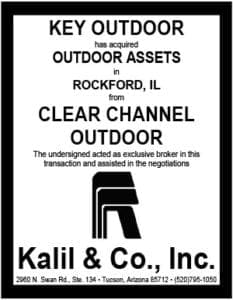 By Carla Gunnin, Jackson Lewis law firm
By Carla Gunnin, Jackson Lewis law firm
Billboard climbers using full-body harnesses and a double-lanyard system comply fully with a new federal safety rule that takes effect in November of next year.
Anchorage points must be able to hold 5,000 pounds, a requirement that mirrors the poundage stated in construction standards for fall protection.
Rules from OSHA (Occupational Safety and Health Administration) are thick and can be confusing. I am going to translate the new rule in plain English, and tell you where to learn more (note: I have been retained by the Outdoor Advertising Association of America to advise the industry).
First, mark your calendars for a no-fee webinar hosted by OAAA on November 29 on billboard-climber safety compliance (2 pm Eastern). This webinar features Jim Poage of Formeto, Chuck Wigger of Lamar Advertising Company, and Chris Zukin of Meadow Outdoor Advertising.
Background
A quarter-century ago, the Feds (OSHA) granted a variance to a company in the billboard industry. This variance became commonly known as the “Gannett variance.” It allowed billboard climbers to be exempt from traditional fall-protection requirements so long as certain requirements were followed. These climbers were termed “qualified climbers.”
Over time, the federal safety agency sought to eliminate the Gannett variance, as well as other exemptions. As OSHA collected comments from the public – for years and years – other segments of the construction industry complained about variances and exemptions as unfair. In addition, OSHA began to believe that improvements in fall protection would allow for its use when climbing all ladders.

OSHA issued a new rule regarding walking-working surfaces on November 18, 2016 . . . more than 500 pages.
The part about billboards said the Gannett variance could remain in effect for two more years. Starting in November 2018, billboards would have to have ladder safety systems, cages, wells, or personal-fall arrest systems.
OAAA asked the federal safety agency for clarification: would a double lanyard system with a body harness qualify as 100 percent fall protection compliance?
OSHA agreed to this so long as companies ensured that lanyards and anchorage points used as part of this system would withstand 5,000-pound breaking limits. See July OSHA interpretation letter (click here). It is very important and valuable to get the government’s position in writing, to validate future compliance.
This written interpretation from OSHA is a major concession by allowing for an alternative fall protection method. In addition, this makes the new rule for billboard climbers similar to fall-protection systems used in the construction industry.
The Trump Administration is attempting to knock out some new regulations. Is it possible that the new Administration would bring back the Gannett variance?
Unlikely. OSHA stated in its last rulemaking on walking-working surfaces (2010) that it believed that the qualified climber exemption (the Gannett variance) was no longer needed as there had been a lot of improvements in fall protection devices to allow for compliance with the rule. With the allowance of the double lanyard system as an alternative fall protection method, it is unlikely that the administration would view the Gannett variance as a needed variance to the standard.
Do I have to install cages or wells to comply with the new rule?
No, so long as the double lanyard method outlined in OSHA’s interpretation letter is used.
Does federal OSHA policy drive state rules?
Usually, but not always. Twenty-one states operate independently from federal OSHA. For most state plans, a letter of interpretation from federal OSHA will have direct bearing on state enforcement. But be wary of certain states that may have their own regulations, such as California, Washington, Oregon, and Michigan. They may not follow federal OSHA guidance. Be sure to check with the state plan or your own counsel if you are unsure of how federal OSHA interpretations apply to a state plan

Carla Gunnin is a principal in the Atlanta, GA, office of Jackson Lewis. She is co-leader of the firm’s practice group on Workplace Safety and Health.
Disclaimer: This Update is provided for informational purposes only. It is not intended as legal advice nor does it create an attorney/client relationship between Jackson Lewis and any readers or recipients. Readers should consult counsel of their own choosing to discuss how these matters relate to their individual circumstances.
[wpforms id=”9787″]
Paid Advertisement

















